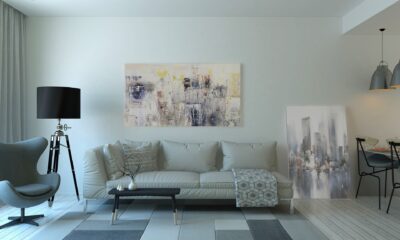Home Improvement
Interior Design Rules to Respect

Decorating a home requires following certain rules if you want it done right, from color palettes and furniture arrangements. Interior design guidelines must be observed if they’re to succeed properly.
Designer Sara Lynn Brennan recommends following the 60/30/10 rule when developing a harmonious color palette. 30 percent shade should come from rugs or accent pieces; 10 percent should come from window treatments or chair fabric.
Dark Tones
Interior designers understand the value or tone of a color is an extremely crucial aspect of interior design and statement pieces, as its lightness or darkness directly impacts its emotional impact. While other factors affect this emotion such as theme, style medium technique, etc can have some degree of an effect but tone alone has much more significant power.
Juan Gris employed soft tones in his painting The Open Window, in which the bright sunlit paper creates an ambiance of peace and serenity. Caspar David Friedrich employed dark tones instead in his piece The Wanderer Above the Sea of Fog depicting a figure standing before snow-covered mountains, rocks, and mist.
Those seeking to add moodier colors to their home shouldn’t be intimidated by experimenting with darker hues; just be sure that your room can support such dramatic tones; smaller spaces may become overwhelmed quickly with darker colors. Also, make sure that there is variety among the tones so as not to appear flat and lifeless.
Two-Leg Rugs
Styling rugs requires many considerations, with one of the key ones being appropriate sizing for any space they inhabit. When styling larger furniture such as sofas, an ideal rug would ideally extend under all front legs as well as at least a couple of inches on either side – this ensures that circulation pathways remain unobstructed and will give enough room for circulation pathways to flow without feeling constrained or squashed on top.
As this living room by Visual Jill illustrates, sometimes it is considered appropriate to only place the front legs of major upholstered pieces onto a rug with their backs off (or pulled out of their respective tables – in the case of dining chairs, even when pulled back out from underneath the table). This approach allows the rug to connect all aspects of seating arrangement without restricting space or creating an enclosed feel.
An additional option for creating a dedicated sitting area in a more open plan room by drawing attention towards a rug is placing all of the furniture pieces directly on top of it – this works especially well when using large area rugs as it helps define an intimate sitting space by drawing people’s gaze towards it. Although this approach might prove challenging if some pieces don’t exactly touch their edges, taking this risky route can look stunning and help pull a room together seamlessly.
Mixing Aesthetics
Interior design should reflect your personal taste. That means incorporating various aesthetics is perfectly acceptable, and often more intriguing than selecting just one style to decorate with. When mixing different styles together, keep this rule of thumb in mind: 80% should conform to your dominant theme while 20% serves as accent pieces.
Your home should feel like one cohesive whole instead of an awkward mix-and-match of different designs that don’t flow together well. Utilizing neutral hues as unifying agents between designs is an excellent idea, while minimalism in terms of the palette is ideal; try using no more than three hues for the best results.
Mixing styles work great when combined with different textures; heavier furniture pieces can be offset by lighter fabrics to avoid your space feeling too bulky; similarly, different materials add visual interest such as distressed wood combined with plush seating arrangements. No matter what style works best for you, experiment at your Memphis discount furniture store to see which pieces work for you!
Keeping It Simple
Keeping it simple is one of the key interior design rules you should follow, enabling you to focus on creating refined and sophisticated results. This concept has been employed in everything from grand buildings to mechanical novelties.
Rugs must be large enough to accommodate all the furniture in a room, and only the front two legs of each piece should rest on it – this helps avoid too much pressure being placed on individual pieces, as well as saving yourself from bruised shins!



